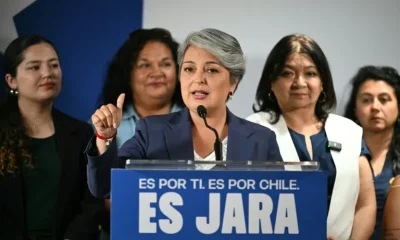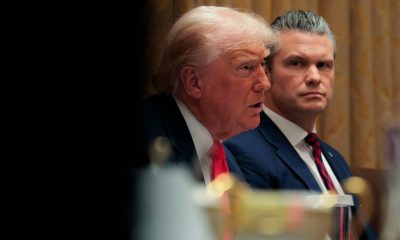International
WHO wants to rein in meningitis by 2030

AFP
The World Health Organization unveiled a plan Tuesday to bring meningitis under control by 2030, slashing the 250,000 annual deaths caused by the debilitating disease.
Launching the first-ever global strategy to tackle the illness, the WHO said it wanted to eliminate epidemics of bacterial meningitis — the most deadly form.
By doing so, it hopes to halve the number of cases and reduce deaths by 70 percent. It also wants to significantly reduce disability caused by the disease.
“Wherever it occurs, meningitis can be deadly and debilitating; it strikes quickly, has serious health, economic and social consequences, and causes devastating outbreaks,” said WHO chief Tedros Adhanom Ghebreyesus.
“It is time to tackle meningitis globally once and for all — by urgently expanding access to existing tools like vaccines, spearheading new research and innovation to prevent, detect and treat the various causes of the disease, and improve rehabilitation for those affected.”
Meningitis is a dangerous inflammation of the membranes that surround the brain and spinal cord, predominantly caused by infection with bacteria, and other pathogens including viruses and fungi.
Meningitis caused by bacterial infection tends to be the most serious form as it can spark fast-spreading epidemics.
It kills one in 10 of those infected — mostly children and young people.
It also leaves one in five with long-lasting disability, such as seizures, hearing and vision loss, neurological damage and cognitive impairment.
Over the last 10 years, epidemics have most commonly occurred in the so-called “Meningitis Belt”, spanning 26 countries across sub-Saharan Africa from Senegal to Ethiopia.
Outbreaks can severely disrupt health systems and create vast expenditures for households and communities.
The WHO said there was an “urgent need for innovation, funding and research to develop more meningitis-preventive vaccines”.
Several vaccines protect against certain meningitis types, but many countries are yet to introduce them into their national immunisation programmes.
Research is also under way to develop vaccines for other causes of meningitis, such as Group B Strep bacteria.
The WHO’s Global Roadmap to Defeat Meningitis by 2030 called for high immunisation coverage and improved strategies to prevent outbreaks and respond to them.
It also called for efforts to strengthen early diagnosis, treatment and rehabilitation.
The plan says meningitis will not be eliminated but it aims to get as close to that point as possible by reducing case numbers and then keeping them low.
International
El Chapo’s son Joaquín Guzmán López pleads guilty to U.S. drug trafficking charges

Joaquín Guzmán López, one of the sons of notorious Mexican drug lord Joaquín “El Chapo” Guzmán, pleaded guilty on Monday to drug trafficking charges in a U.S. court, months after his brother Ovidio reached a similar plea agreement, according to local media reports.
The defendant appeared before a federal court in Chicago early Monday afternoon and changed his previous plea in the case, the Chicago Tribune reported. U.S. authorities accuse him of forming, together with his three brothers, the cartel faction known as “Los Chapitos.”
The group is believed to have continued the operations of El Chapo, who has been serving a life sentence in the United States since 2019.
Guzmán López, 39, was arrested after landing in Texas in a small aircraft alongside cartel co-founder Ismael “El Mayo” Zambada.
International
Venezuela authorizes return flights as U.S. continues deportations amid rising tensions

The arrival of U.S. aircraft carrying undocumented Venezuelan migrants continued regularly despite rising tensions between Washington and Caracas over President Donald Trump’s military deployment in the Caribbean.
Trump maintains that the deployment is part of an anti-narcotics operation, while Venezuelan President Nicolás Maduro insists the true objective is to remove him from power and seize the nation’s oil resources.
Venezuela’s aviation authority has “received a request from the United States government to resume repatriation flights for Venezuelan migrants from that country to Venezuela,” the Ministry of Transportation said in a statement .
“Under the instructions of President Nicolás Maduro, authorization has been granted for these aircraft to enter our airspace,” it added.
Caracas will permit two Eastern Airlines flights to land on Wednesday and Friday.
Migration remains one of the Trump administration’s flagship issues. On Monday, the U.S. president held a meeting with his National Security Council to discuss the situation in Venezuela, a day after confirming he had spoken with Maduro by phone, without offering further details.
According to the Venezuelan government, roughly 75 deportation flights have been carried out this year, returning at least 13,956 Venezuelans from the United States.
International
20,000 rounds stolen from german army after driver leaves cargo unattended

The German army confirmed the theft of a shipment of ammunition that occurred a week ago while it was being transported by a civilian delivery driver, a military spokesperson told AFP, confirming earlier media reports.
According to Der Spiegel and the regional broadcaster MDR, around 20,000 rounds of ammunition were stolen from an unguarded parking lot near Magdeburg, in eastern Germany, while the driver was asleep in a nearby hotel. No information has been released regarding the identity of the suspects, and the military declined to specify the exact type or amount of ammunition taken.
Authorities have also not indicated how the perpetrators knew the cargo would be left unattended.
“The theft was discovered upon delivery at the barracks,” the German army spokesperson said.
A police spokeswoman confirmed to AFP that an investigation has been opened but refused to provide further details “for tactical reasons.”
Sources close to the German military, cited by Der Spiegel, believe it is unlikely the theft was a coincidence. They suspect the thieves waited for the driver to stop for the night before striking.
Der Spiegel also reported that the Defense Ministry normally requires two drivers for this type of transport to ensure the cargo is constantly monitored. However, in this case only one driver was assigned, meaning the civilian transport company failed to comply with the security protocols.
-

 Central America4 days ago
Central America4 days agoTrump Pardons Former Honduran President Hernández and Warns of Aid Cuts Ahead of Election
-

 Central America2 days ago
Central America2 days agoHonduras Extends Voting by One Hour Amid High Turnout, CNE Announces
-

 International1 day ago
International1 day agoHong Kong police arrest 13 over deadly high-rise fire that killed 151
-

 Central America3 days ago
Central America3 days agoHonduras’ China–Taiwan Future Hinges on Sunday’s Presidential Election
-

 International4 days ago
International4 days agoMeta Says Russia Seeks to Ban WhatsApp for Defending Secure Communication
-

 International1 day ago
International1 day agoSri Lanka and Indonesia deploy military as deadly asian floods kill over 1,000
-

 International1 day ago
International1 day agoTrump says asylum decision freeze will remain in place “for a long time”
-

 International1 day ago
International1 day agoChile enters runoff campaign with Kast leading and Jara seeking a last-minute comeback
-

 International6 hours ago
International6 hours ago20,000 rounds stolen from german army after driver leaves cargo unattended
-

 International6 hours ago
International6 hours agoVenezuela authorizes return flights as U.S. continues deportations amid rising tensions
-

 International6 hours ago
International6 hours agoTrump convenes National Security Council as U.S.–Venezuela tensions intensify
-

 International6 hours ago
International6 hours agoEl Chapo’s son Joaquín Guzmán López pleads guilty to U.S. drug trafficking charges






























